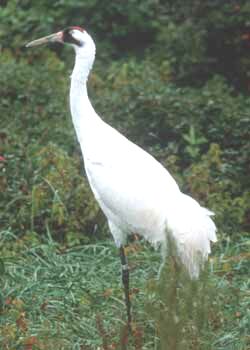Where it lives
The Whooping Crane lives in the marshlands of northern Canada.
Appearance
Cranes are the tallest birds in North America - up to 1.5 metres tall.
They have long black legs. Cranes wade (walk in the water ) in the marshes.
adult crane and young crane
The fully grown crane has a red patch on the top of its head ,
a long white neck and a white body,
except for the black feathers on the tips of the wings.
It has a moustache of black on either side of its dark beak.
The wings measure over 2 metres from tip to tip.
The young are reddish-brown in colour.
The young
The mother lays two eggs in the nest made of marsh plants.
The nest is built in the shallow water. The baby is covered with soft reddish down
(feathers).
young crane and 2 adults
Food
Whooping cranes feed on crayfish, frogs amd other small animals
that live in the water.
They also eat roots and waterplants. During their migration
they have been seen feeding on grain that was left in the farmers'
fields after the harvest.
Adaptation
With their long beaks and long legs,
they are able to get small animals that live in the water.
The whooping crane's wings are very strong.
This helps it to make the long flight to its winter home in Texas.
Whooping Cranes rest in the marshy areas near Regina and Moose
Jaw (Saskatchewan) when they are migrating. They also stop in farmers' fields to rest
and eat grain.
three cranes in the water
Interesting things
The Whooping Crane got its name from the booming call it makes when
angry or disturbed. Some say it makes a bugle-like trumpeting sound.
Cranes dance - making loud noises, flapping their wings ,
bowing their heads and then leaping into the air.
By 1941 there were only 22 whooping cranes left in the world.
Whooping cranes were hunted for their beautiful feathers.
Today these cranes still have a problem surviving because :
- The marshlands are disappearing.
- People shoot them.
- They fly into power lines.
- They die from diseases ( or pollution ).

There are about 407 whooping cranes in the wild in North America (2010).
There are 263 Whooping Cranes nesting in Wood Buffalo National Park (northern Alberta-Northwest Territories)
. They fly from Aransas Wildlife Refuge in Texas to this park every spring to nest and raise
their young.
CANADIAN ANIMALS |
FACTS about Whooping Cranes
MORE INFORMATION ABOUT THE WHOOPING CRANE
1. Bring Back the Cranes news updates, reports
2. WHOOPING CRANES information,migration
3. HINTERLAND - Whooping Crane
info and photos
images:
- cranes.jpg, cranes2.jpg, cranes3.jpg courtesy of SERM
(Sask. Environment and Resource Management)
- USFW United States Fish and Wildlife Services
J.Giannetta
jgiannet@hotmail.com
2001, updated 2011
Web Pages for Students
| 
